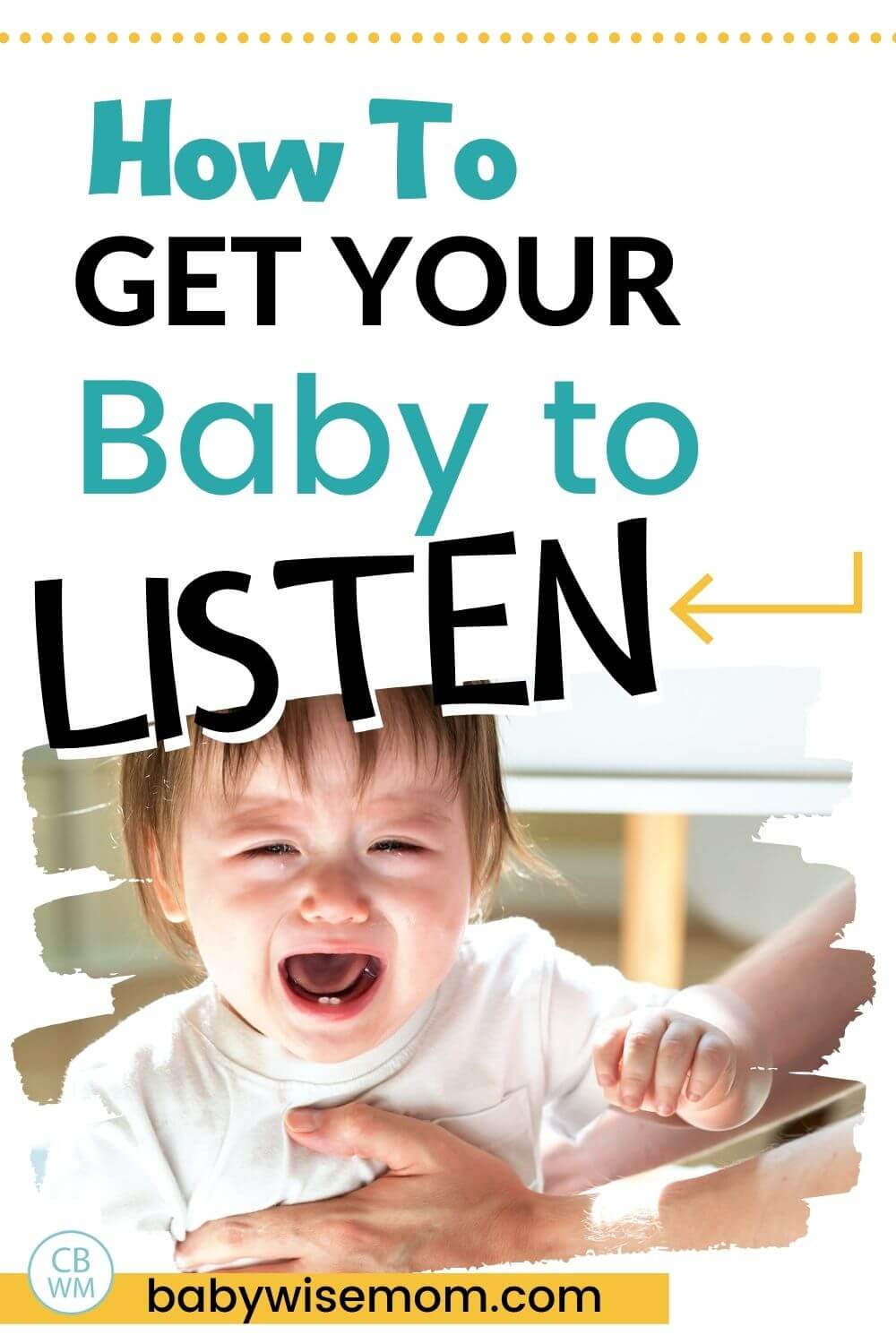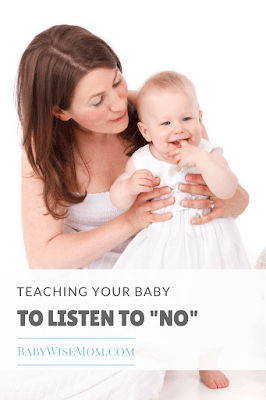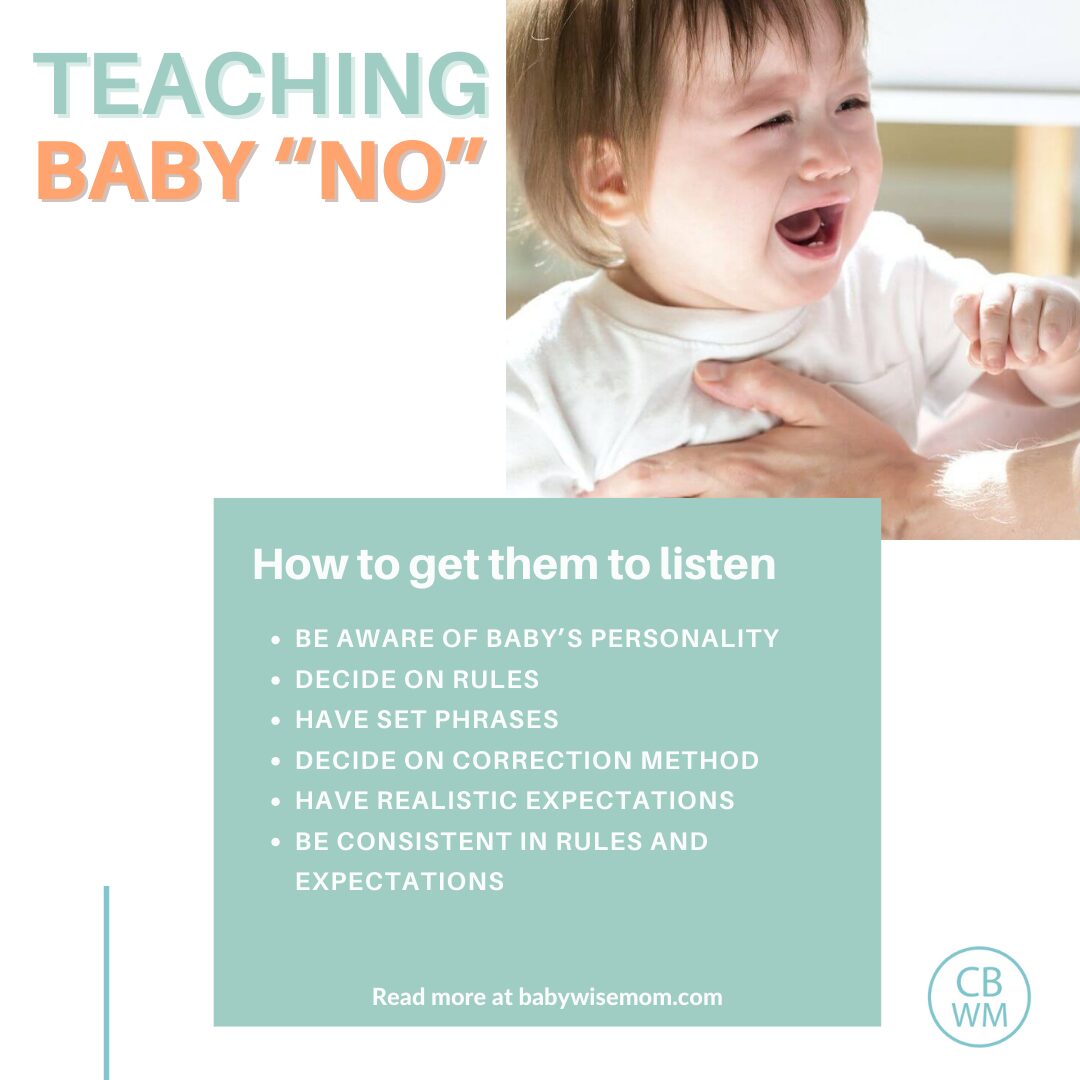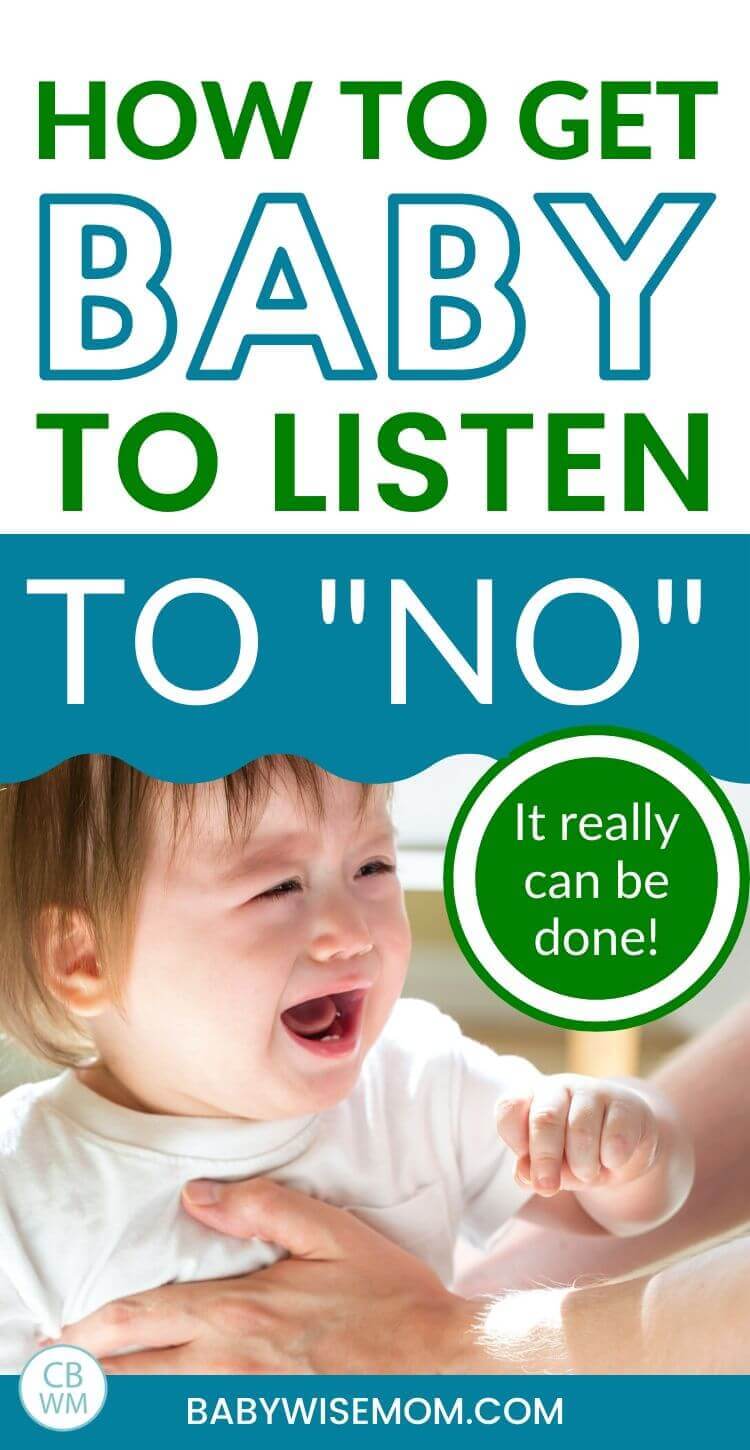Teaching your baby to listen to the word “no.” Baby can understand what no means and respond appropriately. This post discusses how to accomplish this.

Many people believe a baby is not capable of understanding the word no until they are “older.” I am not sure exaclty what age “older” is, but it seems to be older than baby is at the moment or until baby is around a year.
Once baby hits a year and becomes a toddler, then baby just won’t listen.
The truth is, baby will learn words early on that are heard often.
I distinctly remember my children showing an obvious understanding of the word “kisses” at 5 months of age. Every time I kissed them, I said “Kisses!”
At 5 months, they started giving me kisses with them initiating it. So I would ask for it, and they would comply and come at me with a wet, slobbery, open-mouthed kiss (which I of course loved).
Despite the fact that I belive my children to be very smart, I do not think they are unique in the ablity to understand words at a young age. Other children can understand words that young, also.
Children understand words long before they are able to speak them.
As soon as you see a need for correction, I would recommend introducing the method you are going to follow.
You need to choose what you want your method to be. The word “no” can easily become overused, but I don’t think that needs to be stricken from your vocabulary.
Post Contents
Tips to Teach Your Child To Understand “No”
Here are some strategies I used to correct my children even as babies. Even a baby needs to be corrected at times.
Here are some tips to help you get your little one to understand and listen when you say “no.”
Become Aware of Your Child’s Personality
If you aren’t naturally an intuitive person when it comes to people’s personalities (not everyone is), work to learn how to do so.
I think the job of mother quickly teaches us this skill, but the sooner you become good at it, the better.
This requires you to accept the fact that every person has their own strengths and weaknesses. Every person, including babies, have their own personalities.
We are all different, view things differently, and communicate differently. Try to get to know your child.
One big impact on your child’s personality will be birth order. Read up on that here.
Brayden has always been a dutiful child who is very obedient. He does what he is asked far more often than the averages given in Toddlerwise.
When Kaitlyn came along, I could tell she was a little more intent to do what she wanted; however, she also tested her boundaries far less often than Brayden did.
McKenna was a strong-willed baby and toddler. She tested and pushed boundaries often. Brinley always seemed so easy as a baby.
Does your child respond better to positive reinforcement? Most, if not all, do.
Some are far more in need of positive reinforcement than others, though. My husband is one. He needs to be told he is doing a good job.
If there is ever something I want him to be better at doing (like, putting his socks in the hamper), the best way to go about it is for me to wait, catch him in the act, and thank him for doing so. He will then do it consistently.
If I go to him and say, “I would like it if you put your socks in the hamper instead of on the floor,” he would not respond as well.
Does that sound odd? Honestly, it does to me. I would rather you come up to me and tell me to put my socks in the hamper. But my husband is the way he is.
It took his parents several years to figure this out when he was a child, but they say it made a world of differnce with him.
Brayden is the same way. I recognized it somewhere between 6 and 9 months. There was no question I had another “praise junkie” on my hands. I don’t mean praise junkie in a bad way; they just need more praise than I do. I believe Kaitlyn is more like me in that area.
As the years went by, I learned about the 5 Love Languages. Your love languages has a huge impact on how you respond to correction. Little ones who like a lot of prase might have words of affirmation as their primary love language.
No matter how strong the inclination toward this, your child will prefer to be thanked for doing a good job to being scolded for a bad one.
Get to know your child and you will have an easier time adapting discipline for him or her.

Decide on Rules
Before you can correct a child for doing something wrong, you have to decide what “wrong” is. Certain things are obvious, but other things will be depended on you.
Do you want baby to be able to pull your hair? Do you want baby to be able to put fingers in the food? Do you want baby to blow raspberries while eating? Do you want baby to touch the plant?
Look around and set some boundaries.
When Brayden was a baby, I didn’t have much in his path that I minded him touching. I had set the house up so that it wouldn’t be in his way.
When he was around 9 months, I remember establishing a couple of things as “off-limits” for him to touch, not because I necessarily minded the way he played with them then, but I knew he potentially would get more aggressive in his play as he got older.
I also wanted to have some things to be able to start working on obedience with him.
So make sure you have changes to correct your little one.
Another hint for rules, make sure you and your spouse are in agreeance on the rules and boundaries. Consistency is very important with correction.

Decide on a Phrase
On Becoming Babywise II (affiliate) has the phrase idea of “that’s a no.” I love that–it is what I use. I like it better than a simple “no” because it takes more effort for me to say, so I know I won’t start to say it out of habit.
I also think I am able to say it with more conviction that just “no.” Pick whatever phrase you want. Keep it consistent.
When your baby does something or touches something she shouldn’t, use your phrase.
So if baby grabs the houseplant, you say, “That’s a no.”
Decide on a Method
You need a game plan of how to respond. You want to be consistent so your child knows what is okay and what isn’t.
Your goal here is to teach baby to listen when you tell her no. You don’t want her to just understand that “no” means it isn’t okay. You want her to stop the action.
Here is the method I followed.
First, I said the name of the child to establish eye contact. I have a look I give my children when they do something they shouldn’t.
Without thinking, I give the look before I say anything else. When Kaitlyn was 9 months old, she would respond to just the look without me having to say a word.
After the look, I would say, “That’s a no” firmly.
Remember what Babywise II says about letting your child have some dignity. If you have a strong-willed child, it might be good to look busy with something after you say, “That’s a no” and give your child the chance to stop doing what he is doing without feeling like he is losing some battle.
>>>Read: How to Keep Your Kiddo Still for Diaper Changes
If he doesn’t stop, I would repeat the above steps.
Also, give your child some time to respond before you take your actions further. Your baby needs to process that you said no, decided whether or not to listen, and then respond.
At that point, redirection is a good idea. If he is playing with the plant and you tell him that is a no, suggest you read a book or play with this or that toy.
Give him some ideas to move on to.
If he will not listen, then you physically move him to another activity. You even thank him for stopping. “Oh thank you for stopping touching that plant. Let’s come over here and play with these toys.”
So let’s recap the steps here:
- Get the mom look
- Say your baby’s name
- Wait for eye contact before giving instruction. If your baby will not look at you, physically go to your baby so your baby must look you in the eye. You can even gently turn your baby’s head to look in your eyes if needed.
- Say, “That’s a no.” You might even add “We do not touch the plant.”
- Pretend to be busy with something so your child can surrender with dignity. Give him a chance to stop.
- If he doesn’t stop, repeat steps 1-5. Add in some redirection. “That’s a no. We do not touch the plant. Come play with these toys over here.”
- If you get here and he isn’t listening, physically move him somewhere else.
- No matter the point when he listens (even if it is step 8), thank him for listening to you.
Note that with older ages, you will start to add in a “yes, mommy” step.
>>>Read: How to Discipline Your Strong-Willed Child
Have Realistic Expectations
Can you expect your baby to respond to your directions?
Absolutely!
You should expect a response. People rise to expectations. Even babies. But keep your expectations within reason.
What is within reason? Toddlerwise says a two year old will comply 60% of the time. A three year old, 70%. A five year old, 85-90%. That gives you an idea of what you can expect from your baby.
This doesn’t mean that if you have a two year old you accept him ignoring you 40% of the time. You don’t say, “Oh, this is in that threshhold, I’ll move on and try again.”
It just means your child is normal and for his age when he doesn’t listen. You still work on getting obedience and still follow through on the steps above (these statistics found on page 94 of Toddlerwise).
>>>Read: How Often Can You Really Expect a Child to Obey
Payoff
When Brayden was 11 months old, we went to visit some friends. They had no children yet and had some nice books right at his eye level.
He was drawn to them. He went over and I told him, “that’s a no.”
He left them alone for a while. He returned several times to the books, but never touched them.
I was glad to be able to visit somewhere and be able to require my child to respect the property of others. I was glad I could tell him something was off-limits without a crying fest breaking out.
When Brayden was a young toddler, I was pregnant with Kaitlyn. I didn’t feel well ever during pregnancy. At our park, we have really steep stairs that lead to a high playground.
It isn’t safe for a young toddler alone.
He would go to the stairs and I would call out, “Brayden!” and wait for him to look at me. “That’s a no.” He would then shake his head no and move on to something else.
I didn’t have to run after him. If I did, we wouldn’t have spent much time at the park. So it was to the benefit of both of us that he listened.
As I mentioned earlier, Kaitlyn really didn’t test me as much, but things happened.
One day, she blew raspberries with a full mouth of food. Not fun for me to wear baby food. I just gave her a look and she stopped.
Her personal biggest challenge was biting me while nursing.
Kaitlyn had no teeth yet, but every now and then got a glint in her eye and slowly bit down. It didn’t hurt in the least, but I would tell her firmly “Kaitlyn, that’s a no, you don’t bite your mamma” and detach her.
It was hard for me not to smile because she knew what she was doing was wrong and got a kick out of it…but I knew I wouldn’t be smiling once those teeth came in, so I wanted to correct this issue before she got those pearly whites.
As time went on, she got to the point that would see that glint enter her eyes and I just gave her a look that said no.
She just smiled at me and continued on without biting. She had a little smile on her face, like she had been caught and thought it amusing, but no biting.
Conclusion
Babies will test their boundaries. Babies are little scientists.
Are the boundaries the same today as yesterday? They want to know.
Keep your patience and teach them over and over what is and isn’t acceptable. Remember, consistency, consistency, consistency!
So long as you keep your expectations in check, you can start to teach your child to obey from a very young age. It will make your toddler years a lot easier.
Related Discipline Posts
- Discipline Foundations for Your Baby
- Discipline 101: The basics of correcting children
- Actions Precede Beliefs
- How to Respond When Your Kiddo Tells You “No”
- Distraction as a Discipline Tool
- Encouragement as a Discipline Tool
- Teaching Child to Come When Called

Reader Comments
- jahanschen said…
I can see the glint in your daughter’s eye because my son does the same thing! He started biting at about 2 months. I would tell him “no bite” sternly and tap his cheek. He is 6 months now and still has no teeth; however, he is teething and I can tell they’re coming soon. When he looks at me like that, I know what’s coming and I say “no bite,” and he doesn’t! I want to breastfeed for a year, so I was quick to nip it in the bud. I have also raised a couple of teething puppies. I hate to say it, but the same thing works with them!
February 5, 2008 12:24 PM
Plowmanators said…
It’s true, many of the same ideas can be applied to both human babies and animal babies. I was raised around animals my entire life. Consistency is something important no matter what the species 🙂
February 5, 2008 12:55 PM
Reader Questions
- Katey Magill said…
What do you think about hand slapping/ flicking/ squeezing?February 22, 2008 1:10 PM
Plowmanators said…
This is a very sensitive subject for many people. Personally, I don’t do any of the above or spanking.However, I really do think most parents do the best job they can for their children. If they think spanking is the best option and works, it isn’t my job to judge that.I do think that the parent can find another way. There are a variety of discipline methods out thre. I think if you spend some time getting to know the personality of your child an his or her currency, you can come up with something that doesn’t involve physical means.If I were to find that a child I had would only respond to spanking, I would have some basic rules for myself. One would be that I could never do it while angry or frustrated. No one really thinks they will go to far, but it happens. The best person in the wrong situation can do wrong things. I find it better to just stay as far from the line as possible. You might wonder how you could ever be angry or frustrated toward your sweet baby…just wait until he is a toddler :-). Another rule for myself would be one swat. Another rule would be it can’t be hard enough to cause pain at all, only to get attention. Like I said, it isn’t what I do or what I would do. I am sure it works for some kids, but I also think something else would work equally as well or better. Other things do take more time and effort, though. But even my 10 month old has responded to nothing but verbal correction. It can be done! That’s my opinion.
February 22, 2008 2:50 PM - LHS Class of 1998 said…
Val-First as a daily follower of your blog, I want to wish you and your family a HUGE congratulation on your new baby news!!!! I remember and older comment of yours about purchasing a video monitor for your 3rd baby because you have all the girl/boy things. I just bought one a few months ago for my 10 month old and I can’t tell you how MUCH I love it! You will be very surprised what they do during their naptimes that you never knew (stand up, roll around, sit up, and then go back to sleep without a sound!)Okay here is a question that I have really being wanting to ask you pertaining to discipline:- First, I love your/Babywise “that’s a no”. I have been using this line since day with my little guy and he has always responded amazing well to it. Lately for the past week with the things that he knows is a “no” he has been testing his boundaries and “touching” or “going” with it. What do you suggest for this behavior? Do you just remove them, squeeze their hand, swat their hand, etc. I would love a good detail suggestion of what you do for this area of discipline.As always Val, thank you so much for your writings. We especially thank you during this time of pregnancy for answering our questions!!Megan:-)
September 26, 2008 9:10 PM - Plowmanators said…
Megan, Thanks for the congrats! Thanks about the video montior. We have already been looking into them. I think it will be awesome.His behavior of testing limits is totally normal and will happen over and over throughout his life :). But that doesn’t mean you sit back and accept it. I will first direct you to these posts, then let me know if you need further clarification: How to Know What Freedoms To Give Baby, Discipline Strategy: Surrender with Dignity, The “Mini-fit” , and this is for older, but you might find some ideas: Tantrums and Discipline
September 29, 2008 11:27 AM

This post originally appeared on this blog in January 2008
